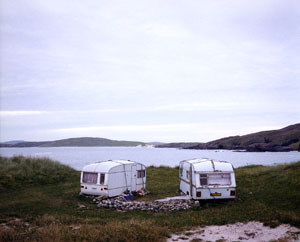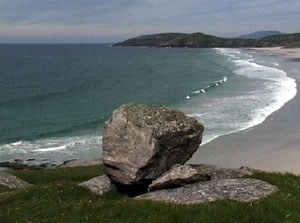
 |
Matthew Dalziel, Louise Scullion + Jean-Luc Schwenninger
The Drowned Sea
During the summer of 2002 we spent three days in Barra with Jean-Luc Schwenninger, a physical geographer with an interest in climatic change. The choice of location was Jean-Luc's, as he had a long-standing affinity with Barra. As a small island in the Outer Hebrides, Barra harbours a unique and dynamic geological history as it has been subjected to profound global changes in climate and sea levels over the past 120,000 years.
As artists who have an interest in landscape and its influence on mankind, it was fascinating to spend time with Jean-Luc who looked at the landscape entirely differently. His eyes seemed focused on somewhere far more distant, able to sense remnants and clues of past activities of a time when the landscape was inhospitable to mankind.
Our eyes, on the other hand, seemed short sighted by comparison. When we visited sand dunes, which at first looked abandoned, Jean-Luc pointed out a series of traces that were clues to the locations of distant and recent pasts. A thin dark rim orbiting the bowl of the dunes we stood on, about a meter or so below their top, marked a place that had once been topsoil, nurturing vegetation. The dark streak was remnants of roots and leaves, long since decomposed and squeezed under the tremendous pressure of sand, followed by ice, to become a thick line that could be read by a knowing eye. But this was not the only secret that the dunes yielded.
More recently the erosion of the dunes has been a cause for concern amongst those who live on the island. The dunes formed a sand bar between two landmasses and, if the erosion was left unchecked, the archipelago of islands would continue in their organic mutations and separations. And so what looked like the natural growth of some wild iris became instead a strategic front to stabilise the shifting sand; so too was a straggling line of wooden pallets constructed in defence of the slow but constant winds.
On another day we visited a beach that looked like any other yet, over on the far side, an area attracted Jean-Luc. He knew by its raking angle amongst the cliffs that the site represented a raised beach of some kind. On further investigation he could tell by the brittleness of the boulders trapped among ancient sand, that the area had been exposed to enormous pressure. The formation of the rocks was exactly that of the contemporary beach seen just 50 yards or so away. Jean-Luc took readings and samples and would return to his laboratory to establish the precise date that the beach had last been exposed to light. From its height however, one could deduce that the beach had been the product of a sea six meters higher than its contemporary relative.
Over the three days we spent in Barra, time and again, we had cause to think about the tumultuous and prolonged pattern of change that these islands and others like them had experienced. An ongoing metamorphosis and recycling of materials had taken place, which to our modern eyes seems unimaginable. Yet this slow and shifting pattern continues as surely as life itself. From the material gathered during this time, we have produced a short video work entitled 'The Drowned Sea' and have drawn up plans for an artists' multiple which can be worn, containing sands from the ancient beach.
Matthew Dalziel, Louise Scullion
 |
If the elaboration of carbon were not a common daily occurrence, on the scale of billions of tons a week, whenever the green of a leaf appears, it would by full right deserve to be called a miracle.
This refined, minute, and quick-witted chemistry was 'invented' two or three billion years ago by our silent sisters, the plants, which do not experiment and do not discuss, and whose temperature is identical to that of the environment in which they live.
If to comprehend is the same as forming an image, we will never form an image of a happening whose scale is a millionth of a millimeter, whose rhythm is a millionth of a second, and whose protagonists are in their essence invisible."
From The Periodic Table by Primo Levi 1995